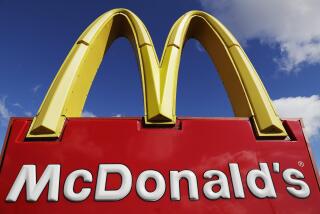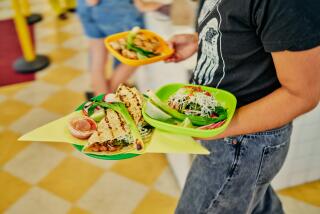Budget Gourmet Foods to Be Independent
- Share via
As Ernest Townsend recalls it, most of his friends at General Host Corp. thought it was a bad idea.
“Don’t touch it,” they said. “It will ruin your career.”
But Townsend believed there was a gaping niche in the marketplace for good-tasting, inexpensive frozen entrees, and he persuaded Harris Ashton, chairman of Stamford, Conn.-based General Host, to back the venture. Ashton’s prime stipulation was that the items taste good, a judgment that consumers have since seconded.
After Orange-based All American Gourmet Co.’s line of Budget Gourmet frozen foods first appeared in markets in late 1983, sales surged to $91 million for fiscal 1985 and are expected to reach $200 million this fiscal year.
Annual sales could hit $750 million within five years, Townsend said.
Despite this success, General Host’s interests have shifted, and the company now plans to divest itself of its 80% stake in All American.
“In one form or another, General Host plans to divest the company,” said Townsend, whose agreement with General Host allowed him to establish a headquarters wherever he chose. Townsend chose Orange and set up offices a few miles from his home.
Among the options General Host is considering for All American are a convertible debenture offering, the sale of its majority stake to an outside investor or a series of smaller stock sales.
All American’s road to independence began in September, 1985, when General Host sold 20% of the stock in All American, or 1.5 million shares, through a public offering at $13 a share. General Host retained 80%, or 6.2 million, of the total shares. On Monday, All American closed at $25, up 25 cents in over-the-counter market trading. A two-for-one stock split on April 18 will boost the outstanding common stock to 15.4 million common shares.
All American’s formation followed the breakup and sale of Tambellini Foods, a unit General Host acquired in 1978. Tambellini had sputtered for several years, selling pizzas, sandwiches, dumplings and 181 other food products, including wafer steaks, “the only product I ever saw with negative sales,” Townsend said, recalling how more of the product was returned than sold.
General Host sent Townsend to Pittsburgh, Pa., in January, 1983, with a mandate to improve Tambellini’s production, marketing and distribution. His first move was to sell off about 120 items from the unit’s 184-item product line, thus saving $350,000.
General Host gave Townsend the $350,000 he had saved at Tambellini to develop the All American project.
Nearly every marketing success story involves finding a market niche, and Townsend was sure he had found one in the gap between frozen, low-priced “belly-fillers,” as they are referred to in the industry, and expensive frozen cuisine offerings.
Within 30 days, three Budget Gourmet test entrees developed by Mimi Tattoli of Fullerton were developed and fed to test groups. Tattoli runs her own food development company and Townsend lavishes praise on her when discussing Budget Gourmet’s success. “They gotta taste good or they won’t sell,” he said.
Apparently, the containers also have to look good.
Test groups rejected the original Budget Gourmet carton artwork, saying the large “Budget” lettering connoted cheap food. With the printing date 14 days away, Hal Silverman, a Los Angeles-based package designer, came up with a design that had “The Gourmet” in large block letters and “Budget” in smaller script.
“You know when you got it,” Townsend said. They shipped the design to the printers.
The first products arrived in grocery freezer sections in October, 1983, and demand was so great that General Host approved a $5.5-million expenditure in mid-1984 for a high-speed production line.
The company spent $6 million on advertising in 1984 and plans to spend $16 million this year, Townsend said.
So quick was the expansion and production demand that Mike McGrath, director of marketing, once raced to a nearby Pittsburgh area farm to pick squash with the field hands. Another time, the company ran out of the Chablis wine used in some of the entrees and went out and bought up all the Chablis in 20 nearby liquor stores.
Budget Gourmet’s product line currently has a dozen entrees, including clams marinara and bay shrimp and linguine. Just-in-time inventory practices mean fresher ingredients are used, Townsend said.
In addition to its principal production plant in Pittsburgh, All American opened a second plant in Atlanta in September, 1985, and a third facility in Clearfield, Utah, is expected to be on line by year’s end. A fourth plant is in the discussion stages and would probably be somewhere in the central states.
Divesting itself from All-American appears to make sense for General Host, whose main interests are running Frank’s Nursery & Crafts, Hickory Farms of Ohio stores and American Salt Co. General Host has said it may also sell Hickory Farms and American Salt when it needs the capital to finance continued expansion of the nursery and crafts chain.
Townsend attributes Budget Gourmet’s success in part to the company’s low overhead. By utilizing a combination carton-tray-lid, the company trimmed packaging costs by 30%. The containers can be placed directly in the oven or microwave.
For consumer convenience, all Budget Gourmet items can be heated at the same temperature for the same length of time. Achieving that involved detailed calculations about the size and weight of each food item and the configuration of the cartons.
Prices are also standardized: $1.69 for the single-serving portions in all but a few large metropolitan markets of the nation, where they sell for $1.79.
The eight-item Slimline Budget Gourmets sell for $1.79, and the eight full dinners, which were introduced in January, sell for $1.99.
For its most recent fiscal year ended Jan. 26, All American reported net income of $4.8 million, more than nine times the $514,000 reported for the prior year.
More to Read
Inside the business of entertainment
The Wide Shot brings you news, analysis and insights on everything from streaming wars to production — and what it all means for the future.
You may occasionally receive promotional content from the Los Angeles Times.









